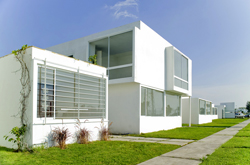Buildings consume between 30-40pc of global energy, according to the United Nations Environment Programme, so how can the move to green buildings address climate change and meet local needs?
With World Green Building Week taking place this week (20–26 September), the World Green Building Council (WorldGBC) has released a report – Tackling Global Climate Change, Meeting Local Priorities – which is timely in the lead up to the United Nations Climate Change Conference (COP16) that’s being held in Cancun, Mexico, from 29 November to 10 December 2010.
The WorldGBC report aims to highlight how green buildings can play a valuable role in meeting local needs worldwide, including in areas hit by natural disasters, as well as providing the most cost-effective way of tackling climate change.
“In the past, some thought we could only address environmental concerns when the going was good and that ‘green’ had to take a back seat to economic growth when times got challenging,” says Jane Henley, CEO of WorldGBC. “This report shows that to be a false choice. We have a growing evidence base of international examples in which homes, buildings and communities are addressing pressing local needs and reducing carbon emissions at the same time.”
According to WorldGBC, green buildings typically cost only 3-5pc more than standard buildings to construct, but can reduce carbon dioxide emissions by more than 35pc – and in some instances can also be carbon neutral.
The reports points to how green buildings can also reduce waste output by 70pc, water usage by 40pc, and energy usage between 30–50pc, with the potential in some cases to produce energy that can be sent back to the grid.
Paul King, CEO of the UK Green Building Council and chair of the WorldGBC Policy Taskforce, explains: “The challenges facing countries around the world may vary locally, but a common theme remains – the importance of the built environment in providing communities with a high quality of life. As we also strive to radically reduce carbon emissions we can’t miss these win-win opportunities – tackling global climate change and meeting local priorities.”

In Mexico, the Los Silos development provides sustainable, affordable, high quality housing for low-income families. The project consists of 6,000 homes on the outskirts of Tlajomulco, Jalisco
The report brings together case studies from four world regions, showing how green buildings have been used effectively to meet local needs, while also cutting carbon. These case studies cover:
Disaster recovery
Green building councils have worked with local NGOs to recreate greener built environments following natural disasters. Examples include the ‘Build it Back Green’ programme in Australia, which was implemented after wildfires destroyed thousands of homes and killed more than 100 people in Victoria. Also, in the US, after Hurricane Katrina, the US Green Building Council brought local communities together with experts in urban planning, waste and water management, engineering and architecture to play a role in lower carbon reconstruction.
Job creation and local economy
In South Africa, the Kyoto Protocol’s ‘Clean Development Mechanism’ (CDM) is being deployed in Khayelitsha, Cape Town, to retrofit 2,300 homes in a low-income housing area using energy efficiency measures such as insulated ceilings and solar water heaters. Revenue from the CDM is being used to fund a trust to employ and train local residents.
In Bogotá, Colombia, Green City is a mixed-use project that supports the generation of economic activities and jobs for residents and surrounding areas.
Affordable housing and fuel poverty
This area is focusing on the developing new or refurbished greener homes for those on a low income. In Egypt, for instance, the GBC has been involved in the design and planning of the country’s first eco village, which will be located south of Cairo. This is an effort to tackle Egypt’s critical homeless population.
The Pay As You Save (PAYS) idea, which was first put forward by a UK-GBC Task Group, is now being progressed in the Coalition Government’s ‘Green Deal’ and is expected to be in place by 2012. PAYS proposes a new form of financing for low-carbon refurbishment of buildings, allowing homeowners or landlords to access finance to improve the energy efficiency of a property, with the capital repaid over a long period of time from the savings on energy bills.
About the World Green Building Council
The World Green Building Council (WorldGBC) is a network of national green building councils from around the world, aiming to influence the green building marketplace. There are more than 20 established and 50 developing Green Building Councils in countries globally. Click here for more information.